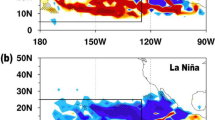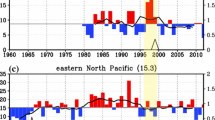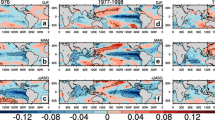Abstract
Interannual relationship between the Pacific Meridional Mode (PMM) and landfalling tropical cyclone (TC) frequency in China (LTCFC) exhibits an interdecadal enhancement since the late-1980s, Epochs I (E1, 1951–1985) and II (E2, 1987–2019) are therefore defined to unravel possible mechanisms. Strengthened low-level vorticity and weakened vertical wind shear always favor TC genesis in the western North Pacific (WNP) main development region (MDR) in positive PMM (PPMM) years of two epochs. During PPMM years of E1, many TCs recurve northeastward due to anomalous westerly steering flow over the MDR while only handful TCs move northwestward and land over China due to climatological mean southeasterly steering flow. In PPMM years of E2, prevailing easterly steering flow anomalies on the MDR’s northern edge cause more TCs to move westward/northwestward and make landfall over China. Therefore, LTCFC is insignificantly (significantly) correlated with PMM during E1 (E2) due to the interdecadal change of steering flow, which is linked to different sea surface temperature (SST) patterns of PMM during two epochs. An anomalous WNP cyclone can be induced during PPMM years of both epochs. A northwestward shift of PPMM-associated positive SST anomalies causes a large zonal SST gradient in the off-equatorial WNP which induces westerlies during E1 while the zonal SST gradient is weak during E2. Thus, westerlies on the southern edge of the anomalous cyclone extend northward, leading to a northward shift of the anomalous cyclone during E1. The distinct responses of two PMM patterns can be well reproduced by the Coupled Model Intercomparison Project Phase 6 models.








Similar content being viewed by others

Data Availability
The ERA5 reanalysis data download from the Copernicus Climate Change Service (C3S) Climate Data Store (CDS) website at https://cds.climate.copernicus.eu/. The ERSST v5 data and climate indices download from the NOAA/OAR/ESRL PSL website at https://psl.noaa.gov/. TC best track dataset downloads from the CMA/Shanghai Typhoon Institute website at http://tcdata.typhoon.org.cn/en/. The CMIP6 model outputs download from the World Climate Research Programme (WCRP) website at https://esgf-node.ipsl.upmc.fr/projects/cmip6-ipsl/.
References
Bartlett MS (1946) On the theoretical specification and sampling properties of autocorrelated time-series. Suppl J R Statist Soc 8:27–41. https://doi.org/10.2307/2983611
Bell B, and Coauthors (2021) The ERA5 global reanalysis: preliminary extension to 1950. Q J R Meteorol Soc 147:4186–4227. https://doi.org/10.1002/qj.4174
Bretherton CS, Smith C, Wallace JM (1992) An intercomparison of methods for finding coupled patterns in climate data. J Clim 5:541–560
Chan JCL (2005) The physics of tropical cyclone motion. Annu Rev Fluid Mech 37:99–128. https://doi.org/10.1146/annurev.fluid.37.061903.175702
Chan JCL, Xu M (2009) Inter-annual and inter-decadal variations of landfalling tropical cyclones in East Asia. Part I: time series analysis. Int J Climatol 29:1285–1293. https://doi.org/10.1002/joc.1782
Chiang JCH, Vimont DJ (2004) Analogous Pacific and Atlantic meridional modes of tropical atmosphere–ocean variability. J Clim 17:4143–4158. https://doi.org/10.1175/JCLI4953.1
Done JM, Holland GJ, Webster PJ (2011) The role of wave energy accumulation in tropical cyclogenesis over the tropical North Atlantic. Clim Dyn 36:753–767. https://doi.org/10.1007/s00382-010-0880-5
Emanuel KA (1988) The maximum intensity of Hurricanes. J Atmos Sci 45:1143–1155. https://doi.org/10.1175/1520-0469(1988)045%3C1143:TMIOH%3E2.0.CO;2
Emanuel KA, Nolan DS (2004) Tropical cyclone activity and global climate. Preprints. In: 26th Conference on Hurricanes and Tropical Meteorology, Miami, FL. Miami, FL: American Meteorology Society, pp. 240–241
Eyring V, Bony S, Meehl GA, Senior CA, Stevens B, Stouffer RJ, Taylor KE (2016) Overview of the coupled model Intercomparison Project Phase 6 (CMIP6) experimental design and organization. Geosci Model Dev 9:1937–1958. https://doi.org/10.5194/gmd-9-1937-2016
Gao S, Chen Z, Zhang W (2018a) Impacts of tropical North Atlantic SST on western North Pacific landfalling tropical cyclones. J Clim 31:853–862. https://doi.org/10.1175/JCLI-D-17-0325.1
Gao S, Zhu L, Zhang W, Chen Z (2018b) Strong modulation of the Pacific Meridional Mode on the occurrence of intense tropical cyclones over the western North Pacific. J Clim 31:7739–7749. https://doi.org/10.1175/JCLI-D-17-0833.1
Gao S, Zhu L, Zhang W, Shen X (2020a) Western North Pacific tropical cyclone activity in 2018: a season of extremes. Sci Rep 10:5610. https://doi.org/10.1038/s41598-020-62632-5
Gao S, Zhu L, Zhang W, Shen X (2020b) Impact of the Pacific Meridional Mode on landfalling tropical cyclone frequency in China. Q J R Meteorol Soc 146:2410–2420. https://doi.org/10.1002/qj.3799
Gao S, Chen Z, Zhang W, Shen X (2021) Effects of tropical North Atlantic Sea surface temperature on intense tropical cyclones landfalling in China. Int J Climatol 41:1056–1065. https://doi.org/10.1002/joc.6732
Gill AE (1980) Some simple solutions for heat-induced tropical circulation. Q J R Meteorol Soc 106:447–462. https://doi.org/10.1002/qj.49710644905
Gray WM (1968) Global view of the origin of tropical disturbances and Storms. Mon Wea Rev 96:669–700. https://doi.org/10.1175/1520-0493(1968)096,0669:GVOTOO.2.0.CO;2
He H, Yang J, Gong D, Mao R, Wang Y, Gao M (2015) Decadal changes in tropical cyclone activity over the western North Pacific in the late 1990s. Clim Dyn 45:3317–3329. https://doi.org/10.1007/s00382-015-2541-1
Hersbach H, and Coauthors (2020) The ERA5 global reanalysis. Q J R Meteorol Soc 146:1999–2049. https://doi.org/10.1002/qj.3803
Hong C-C, Lee M‐Y, Hsu H‐H, Tseng W‐L (2018) Distinct influences of the ENSO‐like and PMM‐like SST anomalies on the mean TC genesis location in the western North Pacific: the 2015 summer as an extreme example. J Clim 31(8):3049–3059. https://doi.org/10.1175/JCLI-D-17-0504.1
Huang B, Thorne PW et al (2017) Extended reconstructed sea surface temperature, version 5 (ERSSTv5): upgrades, validations, and intercomparisons. J Clim 30:8179–8205. https://doi.org/10.1175/JCLI-D-16-0836.1
Kim HK, Seo KH, Yeh SW et al (2020) Asymmetric impact of Central Pacific ENSO on the reduction of tropical cyclone genesis frequency over the western North Pacific since the late 1990s. Clim Dyn 54:661–673
Lee M, Kim T, Cha D-H, Min S-K, Park D-SR, Yeh S-W, Chan JCL (2021) How does Pacific Decadal Oscillation affect tropical cyclone activity over Far East Asia? Geophys Res Lett 48 e2021GL096267. https://doi.org/10.1029/2021GL096267
Li RCY, Zhou W, Shun CM, Lee TC (2017) Change in destructiveness of landfalling tropical cyclones over China in recent decades. J Clim 30:3367–3379. https://doi.org/10.1175/JCLI-D-16-0258.1
Lindzen RS, Nigam S (1987) On the role of sea surface temperature gradients in forcing low-level winds and convergence in the tropics. J Atmos Sci 44:2418–2436. https://doi.org/10.1175/1520-0469(1987)044%3C2418:OTROSS%3E2.0.CO;2
Liu KS, Chan JCL (2003) Climatological characteristics and seasonal forecasting of tropical cyclones making landfall along the South China coast. Mon Weather Rev 131:1650–1662. https://doi.org/10.1175//2554.1
Liu KS, Chan JCL (2018) Changing relationship between La Niña and tropical cyclone landfalling activity in South China. Int J Climatol 38:1270–1284. https://doi.org/10.1002/joc.5242
Velden CS, Leslie LM (1991) The basic relationship between tropical cyclone intensity and the depth of the environmental steering layer in the Australian region. Wea Forecast 6:244–253. https://doi.org/10.1175/1520-0434(1991)006%3C0244:TBRBTC%3E2.0.CO;2
Wang L, Chen G (2018) Impact of the Spring SST gradient between the tropical Indian Ocean and Western Pacific on landfalling tropical cyclone frequency in China. Adv Atmos Sci 35:682–688. https://doi.org/10.1007/s00376-017-7078-2
Wang C, Wang X (2013) Classifying El Niño Modoki I and II by different impacts on Rainfall in Southern China and Typhoon Tracks. J Clim 26:1322–1338. https://doi.org/10.1175/JCLI-D-12-00107.1
Wang C, Wang B, Cao J (2019) Unprecedented Northern Hemisphere Tropical Cyclone Genesis in 2018 shaped by subtropical warming in the North Pacific and the North Atlantic. Geophys Res Lett 46:13327–13337. https://doi.org/10.1029/2019GL085406
Wang C, Fu M, Wang B, Wu L, Luo J-J (2023) Pacific Decadal Oscillation modulates the relationship between Pacific Meridional Mode and tropical cyclone genesis in the western North Pacific. Geophys Res Lett 50:e2022GL101710. https://doi.org/10.1029/2022GL101710
Wu MC, Chang WL, Leung WM (2004) Impacts of El Niño–Southern Oscillation events on tropical cyclone landfalling activity in the western North Pacific. J Clim 17:1419–1428. https://doi.org/10.1175/1520-0442(2004)017%3C1419:IOENOE%3E2.0.CO;2
Wu L, Wang B, Geng S (2005) Growing influence of typhoon on East Asia. Geophys Res Lett 32:L18703. https://doi.org/10.1029/2005GL022937
Wu Y-K, Hong C‐C, Chen C‐T (2018) Distinct effects of the two strong El Niño events in 2015–2016 and 1997–1998 on the western North Pacific Monsoon and tropical cyclone activity: role of subtropical eastern North Pacific warm SSTA. J Geophys Research: Oceans 123:3603–3618. https://doi.org/10.1002/2018JC013798
Wu Q, Zhao J, Zhan R, Gao J (2021) Revisiting the interannual impact of the Pacific Meridional Mode on tropical cyclone genesis frequency in the western North Pacific. Clim Dyn 56:1003–1015. https://doi.org/10.1007/s00382-020-05515-9
Yang L, Chen S, Wang C, Wang D, Wang X (2018) Potential impact of the Pacific Decadal Oscillation and sea surface temperature in the tropical Indian Ocean–Western Pacific on the variability of typhoon landfall on the China coast. Clim Dyn 51:2695–2705. https://doi.org/10.1007/s00382-017-4037-7
Yin X, Huangfu J, Zhou L-T (2020) An interdecadal extension of the Indo-Pacific warm pool and its strengthened influence on the South China Sea summer monsoon since the late 1980s. Environ Res Lett 15:064015. https://doi.org/10.1088/1748-9326/ab8588
Yin X, Zhou L-T, Huangfu J (2021) Weakened connection between East China Summer Rainfall and the East Asia-Pacific Teleconnection Pattern. Atmosphere 12:704. https://doi.org/10.3390/atmos12060704
Ying M, Zhang W, Yu H, Lu X, Feng J, Fan Y, Zhu Y, Chen D (2014) An overview of the China Meteorological Administration tropical cyclone database. J Atmos Oceanic Technol 31:287–301. https://doi.org/10.1175/JTECH-D-12-00119.1
Zhan R, Wang Y, Liu Q (2017) Salient differences in tropical cyclone activity over the western North Pacific between 1998 and 2016. J Clim 30:9979–9997. https://doi.org/10.1175/JCLI-D-17-0263.1
Zhang H, Guan Y (2014) Impacts of four types of ENSO events on tropical cyclones making landfall over mainland China based on three best-track datasets. Adv Atmos Sci 31:154–164. https://doi.org/10.1007/s00376-013-2146-8
Zhang Q, Wu L, Liu Q (2009) Tropical cyclone damages in China 1983–2006. Bull Amer Meteor Soc 90:489–496. https://doi.org/10.1175/2008BAMS2631.1
Zhang W, Graf HF, Leung Y, Herzog M (2012) Different El Niño types and tropical cyclone landfall in East Asia. J Clim 25:6510–6523. https://doi.org/10.1175/JCLI-D-11-00488.1
Zhang W, Vecchi GA, Murakami H, Villarini G, Jia L (2016) The Pacific meridional mode and the occurrence of tropical cyclones in the western North Pacific. J Clim 29:381–398. https://doi.org/10.1175/JCLI-D-15-0282.1
Zhang W-Q, Wu L-G, Zou X-K (2018) Changes of tropical cyclone tracks in the western North Pacific over 1979–2016. Adv Clim Change Res 9:170–176. https://doi.org/10.1016/j.accre.2018.06.002
Zhang W, Vecchi GA, Murakami H, Villarini G, Delworth TL, Yang X, Jia L (2018a) Dominant role of Atlantic Multidecadal Oscillation in the recent decadal changes in Western North Pacific tropical cyclone activity. Geophys Res Lett 45:354–362. https://doi.org/10.1002/2017GL076397
Zhao J, Zhan R, Wang Y, Xu H (2018) Contribution of the Interdecadal Pacific Oscillation to the recent abrupt decrease in tropical cyclone genesis frequency over the western North Pacific since 1998. J Clim 31:8211–8224. https://doi.org/10.1175/JCLI-D-18-0202.1
Zhao J, Zhan R, Wang Y, Xie S-P, Wu Q (2020) Untangling impacts of global warming and Interdecadal Pacific Oscillation on long-term variability of North Pacific tropical cyclone track density. Sci Adv 6:eaba6813. https://doi.org/10.1126/sciadv.aba6813
Zhou L-T (2014) Interdecadal variability in large and small warm pools in western Pacific and their association with rainfall anomalies. Atmos Ocean Sci Lett 7(1):56–61. https://doi.org/10.3878/j.issn.1674-2834.13.0066
Funding
This study was supported by the National Natural Science Foundation of China (Grant number 42175020), Guangdong Basic and Applied Basic Research Foundation (Grant number 2021A1515011573), and Science and Technology Innovation Team Plan of Guangdong Meteorological Bureau (Grant number GRMCTD202105).
Author information
Authors and Affiliations
Contributions
SG designed the study. XW conducted data analysis and drafted the manuscript. All authors discussed the results and comments on the manuscript.
Corresponding author
Ethics declarations
Competing interests
The authors declare that there are no conflicts of interest.
Additional information
Publisher’s Note
Springer Nature remains neutral with regard to jurisdictional claims in published maps and institutional affiliations.
Rights and permissions
Springer Nature or its licensor (e.g. a society or other partner) holds exclusive rights to this article under a publishing agreement with the author(s) or other rightsholder(s); author self-archiving of the accepted manuscript version of this article is solely governed by the terms of such publishing agreement and applicable law.
About this article
Cite this article
Wei, X., Gao, S., Jian, M. et al. Interdecadal change in the relationship between the Pacific Meridional Mode and landfalling tropical cyclone frequency in China. Clim Dyn 62, 1585–1595 (2024). https://doi.org/10.1007/s00382-023-06998-y
Received:
Accepted:
Published:
Issue Date:
DOI: https://doi.org/10.1007/s00382-023-06998-y



